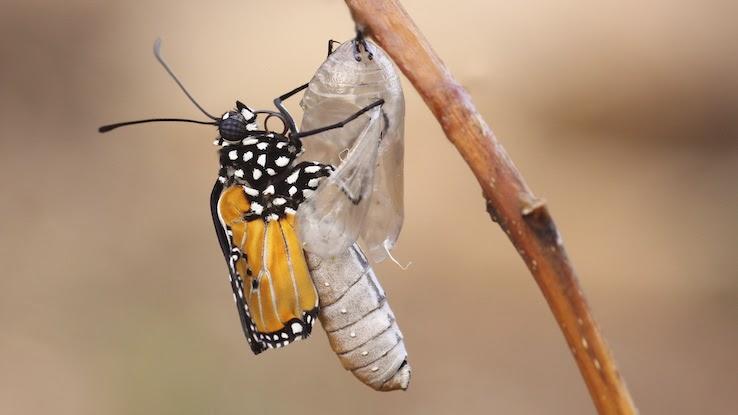What Are Some Symbols of Change and Growth? Things That Represent Change

There are many things that represent change. Some examples of symbols of change are images that represent rebirth or renewal, such as bees, doves, open gates and doors, spirals, and bathing in clean water. Another kind of symbol for change is one that represents complete transformation, such as butterflies, bears, swans and the changing of the seasons.
Philosopher Heraclitus is credited for the famous saying, “the only thing constant in life is change.” Over the course of their lives, many people commit to making personal changes to their mindsets and actions to establish better conditions for themselves. Let’s take a deeper look at some powerful symbols of change, growth and transformation.
Symbols of Change and Growth
To reach new levels in life, we must make a conscious effort to change and grow beyond our current realities. This can involve a change in attitude, a change in discipline or a change in behavior. There are several different symbols of change and growth that may inspire you to take the first step.

One of the most powerful symbols of change is the changing of the seasons — spring, summer, fall and winter. Nature is a reminder that everything changes constantly, and the seasons prove that. Every quarter of the year, we see a new season with new weather conditions and new growth. For example, fall is a season of transition when crops are harvested and preparations are made for the next harvest before the cold and quiet winter. The spring is a symbol of renewal after winter. It’s in this season that new life emerges after the preparations of the fall. Spring can inspire us to start new projects and work on new ideas.
Another symbol, though perhaps an unconventional one, is a haircut. People often get haircuts when they want to change up their appearances. However, sometimes a person gets a haircut to symbolize an important change that they’ve made in their life. For some, haircuts could symbolize moving on after a difficult breakup or getting a new job. For others, haircuts could represent achieving a major weight loss goal or another transformative event that has been challenging but rewarding at the same time.
Symbols of New Beginnings
There are many different symbols of new beginnings that are popular in today’s culture. Often, spring flowers, like daffodils or tulips, are representations of revival after a long winter. A popular flower that’s a symbol of rebirth, regeneration and spiritual enlightenment is the lotus flower. The lotus flower rises through the mud to bloom into a colorful beauty that many people admire. The same can be said for those experiencing new beginnings, particularly after some rough starts or losses. It shows that, even in the midst of darkness, we can always rise up and begin again.

Another powerful symbol of new beginnings is the phoenix. The phoenix, boasting a tail of many colors, is a mythological bird that’s in a constant state of rebirth and renewal. The phoenix is destined to live between 500 and 1,000 years. At the end of its life, the bird builds a nest around itself and ignites into flames upon its death. It burns until nothing but ashes are left. However, from the ashes, a new, young phoenix rises to live another life. For us, the phoenix’s cycle can symbolize ending one way of life and starting another. It can symbolize letting go of bad habits or people to get a fresh start out of life, too.
Flying creatures, such as bees and birds, generally symbolize a new start in life as well. Having the ability to fly gives creatures the freedom to see new places and explore new opportunities.
Symbols That Represent Transformation
Many people look for symbols that represent a transformation in life and even get art or tattoos to keep them as reminders of this progress. One example is the ancient Greek symbol, ouroboros. Derived from the Greek words “oura,” meaning “tail,” and “boros,” which means “eating,” the word roughly translates as “one who eats its own tail.” Often, the symbol is depicted as a serpent or a dragon positioned in a circle, swallowing its tail. However, its symbolism details the continuous nature of every living thing. There’s no true destination in life. Even when we think we have it all figured out, there eventually will come a time to redefine who we are and what we want and to transform into people who espouse those new qualities.

Perhaps the most popular symbol of transformation is the butterfly. The beautiful creature goes through several different stages, starting as an egg before turning into a wriggly caterpillar, a pupa in a cocoon and an adult butterfly. All of these stages are necessary in order for the butterfly to thrive and fly off in its new life. Like a developing butterfly in its cocoon phase, sometimes we must retreat from others to focus on our inner selves and transform into the people we want to become.
What Animal Symbolizes Change?
There are several different animals that symbolize change as well. Swans are seen as symbols of transformation because they transform from small, clumsy cygnets into large, beautiful and elegant adult birds. Another symbol is the chameleon, which changes its color whenever it needs to. It does this for survival and protection, to attract mates or sometimes just because it feels like it. Ultimately, that symbolizes a willingness to change. Often, we hold on to old patterns simply because they’re what we’ve always done, and there’s a sense of security in that. However, it’s important to embrace change and to pursue changes that will make us better people in the long run.

Another animal that symbolizes change is the snake. Snakes shed their skin when it becomes too small, dirty or uncomfortable. They quickly leave their old skin behind to showcase a new, fresh layer of colorful skin. That shedding of old skin symbolizes making inner and outer changes to get rid of anything that takes away from who we want to be in the future. We have to shed old ways of thinking and old actions that are holding us back so we can make room for newer, better things ahead.





